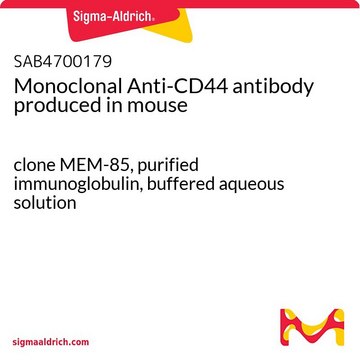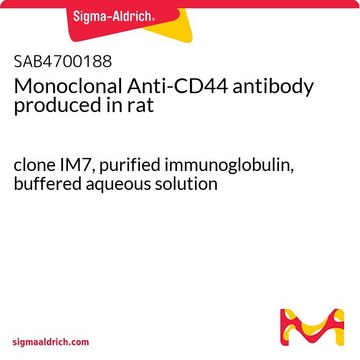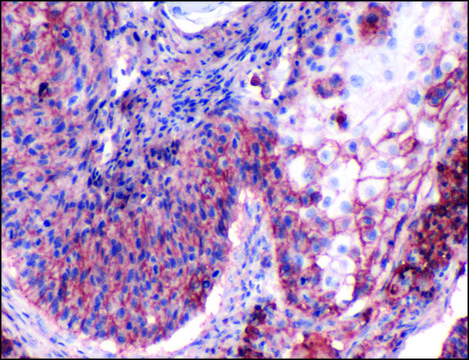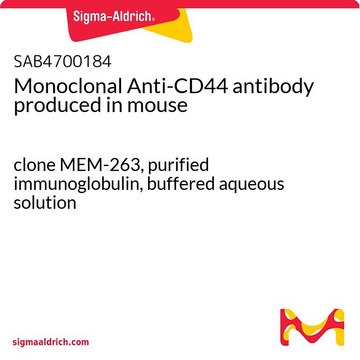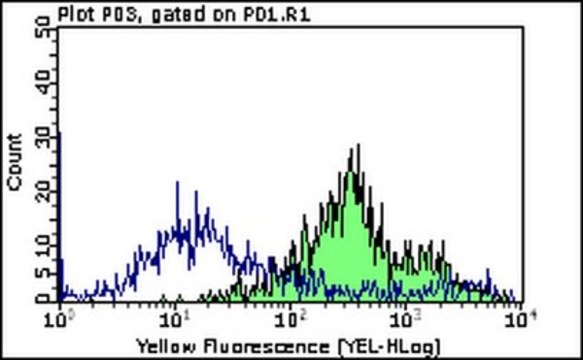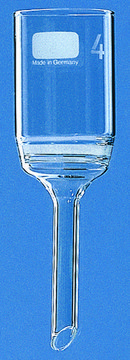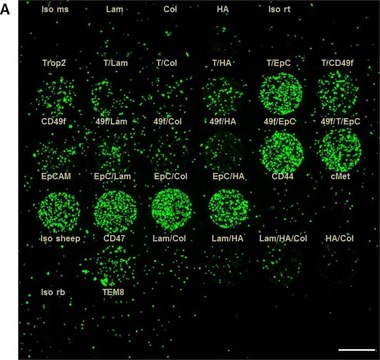C7923
Monoclonal Anti-CD44 antibody produced in mouse
clone A3D8, purified immunoglobulin, buffered aqueous solution
别名:
Anti-CDW44, Anti-CSPG8, Anti-ECMR-III, Anti-HCELL, Anti-HUTCH-I, Anti-IN, Anti-LHR, Anti-MC56, Anti-MDU2, Anti-MDU3, Anti-MIC4, Anti-Pgp1
登录查看公司和协议定价
选择尺寸
所有图片(1)
选择尺寸
变更视图
About This Item
推荐产品
生物来源
mouse
偶联物
unconjugated
抗体形式
purified immunoglobulin
抗体产品类型
primary antibodies
克隆
A3D8, monoclonal
表单
buffered aqueous solution
分子量
antigen 80-95 kDa
种属反应性
human
技术
flow cytometry: 5 μL using 1 × 106 cells
同位素/亚型
IgG1
一般描述
CD44 is a glycosylated cartilage-linked protein. The protein exists in a variety of forms with different molecular structures, ranging from 85 kDa to 250 kDa. It is a multistructural and multifunctional cell surface molecule and involved in various biological processes such as cell proliferation, cell differentiation, cell migration, angiogenesis, presentation of cytokines, chemokines, and growth factors to the corresponding receptors, and docking of proteases at the cell membrane, as well as in signaling for cell survival. Although all the activities are related to normal cell, but it has also some pathologic activities of cancer cells.
特异性
Recognizes the CD44 (80-95 kDa) human cell surface glycoprotein on B and T lymphocytes, monocytes, granulocytes and red blood cells. The epitope recognized by this antibody is sensitive to bromelain and other proteolytic enzymes. It is detectable in routine formalin-fixed, paraffin-embedded tissue.
5th Workshop: code no. BP406, S320
5th Workshop: code no. BP406, S320
免疫原
circulating malignant human Sezary T cells.
应用
Applications in which this antibody has been used successfully, and the associated peer-reviewed papers, are given below.
Flow cytometry/Cell sorting (1 paper)
Flow cytometry/Cell sorting (1 paper)
Monoclonal Anti-CD44 antibody was used as a hyaluronic acid receptor for indirect immunoperoxidase technique in a study to evaluate the relationship of lymphoid cells and macrophages with vasculature and stromal components.
Anti CD44 monoclonal antibody was used for:
Anti CD44 monoclonal antibody was used for:
- immunostaining of nonpapillary carcinoma fine-needle aspiration (FNA) or surgical excision specimen.
- flow cytometry analysis to assess breast CSCs in human MCF-7/Dox breast cancer cells.
- staining of CD44 in immunohistochemistry analysis.
- incubation of osteoclasts (OCs) in a study to analyze the molecular composition and F-actin organization of the OC podosome belts.
- It is also suitable for western blot at a dilution of 1:500-1:2,000
生化/生理作用
The CD44 antigen is expressed on a variety of cell types including peripheral blood leukocytes (B and T lymphocytes, monocytes, granuloctes) and red cells. It is also weakly expressed on platelets. The antibody is also reactive with bone marrow nucleated cells, medullary thymocytes, liver Kupffer cells, fibroblasts, corneal cells, epidermal keratinocytes, synovial cells, a subset of pancreatic acinar cells and brain cells. The epitope recognized by this clone is sensitive to formalin fixation and paraffin embedding.
目标描述
The CD44 antigen has been studied under the following names: Pgp-1, Hermes antigen, ECM-III, H-CAM and HUTCH-1. It functions as a homing receptor. CD44 antigen is the cellular receptor for hyaluronic acid. The antibody is also reactive with bone marrow nucleated cells, medullary thymocytes, liver Kupffer cells, fibroblasts, corneal cells, epidermal keratinocytes, synovial cells, a subset of pancreatic acinar cells and brain cells.
外形
Solution in 0.01 M phosphate buffered saline, pH 7.4, containing 1% bovine serum albumin and 15 mM sodium azide.
储存及稳定性
Store at 2-8°C for up to one month. For extended storage, the solution may be frozen in working aliquots. Repeated freezing and thawing, or storage in "frost-free" freezers, is not recommended. If slight turbidity occurs upon prolonged storage, clarify the solution by centrifugation before use.
免责声明
Unless otherwise stated in our catalog or other company documentation accompanying the product(s), our products are intended for research use only and are not to be used for any other purpose, which includes but is not limited to, unauthorized commercial uses, in vitro diagnostic uses, ex vivo or in vivo therapeutic uses or any type of consumption or application to humans or animals.
未找到合适的产品?
试试我们的产品选型工具.
储存分类代码
10 - Combustible liquids
WGK
nwg
闪点(°F)
Not applicable
闪点(°C)
Not applicable
法规信息
常规特殊物品
含少量动物源组分生物产品
D C Chhieng et al.
Cancer, 81(3), 157-162 (1997-06-25)
Although nuclear grooves and inclusions are considered to be characteristic cytologic features of thyroid papillary carcinoma, a variety of other thyroid lesions may on occasion display these features in fine-needle aspiration specimens. The authors evaluated the immunocytochemical staining of 16
C J Dimitroff et al.
Proceedings of the National Academy of Sciences of the United States of America, 97(25), 13841-13846 (2000-11-30)
We previously have obtained operational evidence of a hematopoietic cell L-selectin ligand expressed on normal human hematopoietic cells and on leukemic blasts. Using a technique developed in our laboratory for analyzing and identifying adhesion molecules, we show here that hematopoietic
Amina Abbadi et al.
The Journal of biological chemistry, 295(15), 4849-4857 (2020-02-29)
Monocytes are rapidly recruited to sites of diabetic complications and differentiate into macrophages. Previously, we showed that rat kidney mesangial cells dividing during hyperglycemic stress abnormally synthesize hyaluronan (HA) in intracellular compartments. This initiates a stress response, resulting in an
Davide Vigetti et al.
The Journal of biological chemistry, 283(7), 4448-4458 (2007-12-14)
The glycosaminoglycan hyaluronan (HA) modulates cell proliferation and migration, and it is involved in several human vascular pathologies including atherosclerosis and vascular restenosis. During intima layer thickening, HA increases dramatically in the neointima extracellular matrix. Aging is one of the
David Naor et al.
Critical reviews in clinical laboratory sciences, 39(6), 527-579 (2002-12-18)
CD44 is a multistructural and multifunctional cell surface molecule involved in cell proliferation, cell differentiation, cell migration, angiogenesis, presentation of cytokines, chemokines, and growth factors to the corresponding receptors, and docking of proteases at the cell membrane, as well as
商品
培养和表征CSC群体的癌症干细胞培养基、球状体培养板和癌症干细胞标志物。
Cancer stem cell media, spheroid plates and cancer stem cell markers to culture and characterize CSC populations.
我们的科学家团队拥有各种研究领域经验,包括生命科学、材料科学、化学合成、色谱、分析及许多其他领域.
联系客户支持